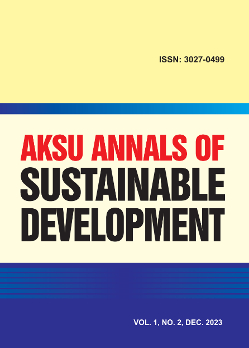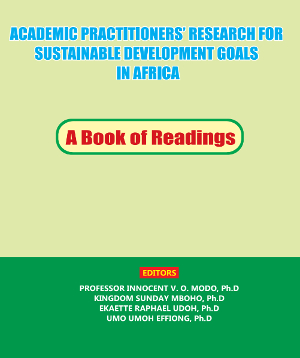AN EXAMINATION OF THE IMPACT OF MACROECONOMIC POLICIES ON DOMESTIC INVESTMENT IN NIGERIA
DOI:
https://doi.org/10.60787/AASD-v2i1-40Keywords:
Domestic investment, Macroeconomic policy, Ordinary Least Square, NigeriaAbstract
This paper examined the impact of macroeconomic policies variables on gross domestic investment in Nigeria for the period (1981-2021), using the econometric techniques of Ordinary Least Square and error correction model for analysis. The result revealed that national income, government capital expenditure and external debt had positive and significant impact on domestic investment. Also, interest rate and market size had positive but insignificant effect on domestic investment. Both exchange rate and inflation rate had negative but insignificant relationship with domestic investment. This study therefore, concludes that macroeconomic policies affect domestic investment in Nigeria, and the drivers of domestic investment in Nigeria in relation to macroeconomic policies as identified in this study are national income, government expenditure especially capital expenditure, interest rate and external debts while volatile exchange rate and inflation rate exerted negative effect. Based on the findings, it is recommended that government policy should be directed toward expanding the productive base of the economy in order to reduce unemployment, increase output and income in the economy, and consequently increase national income to boost investment. Government should ensure that capital
expenditure forms the bulk of total government expenditure and should be prudently employed in the provision of economic and social overhead capital (infrastructure) which is known for complementing private investment. To minimize uncertainty, fiscal policy in the country should be complemented with effective monetary policy in order to handle inflation rate and interest rateissues, and exchange rate management should be intentionally geared toward ensuring relative stability of exchange rate.
Downloads
References
Acosta, P. and Loza, A. (2005).Short and longrun determinants of private investment in Argentina. Champaign: University of Illinois.
Adofu, I. (2010). Accelerating economic growth in Nigeria: The role of foreign direct investment.Research Journal of Economic Theory. 1(5), 35 - 40.
Agbarakwe, W. C. (2019). Determinant of investment in Nigeria: An econometric analysis. International Academy Journal of Management, Marketing and Entrepreneurial Studies. 7 (2), 1- 10.
Agha E., Ukommi A., Ekpenyong O. and Effiong U.(2020).Establishing the Nexus between Technical Education and Industrial
Development in Nigeria.Journal of Research in Education and Society,11(1),38-56.
Agiobenebo, T. J. (2019). Rethinking the expenditure approach to national income accounting and it’smacroeconomic analytics.
Presidential Address to the 60th Annual Conference of the Nigerian Economic Society held on 16th – 18th September, 2019 at The Nigerian Airforce Conference Centre and Suites, 496 Ahmadu Bello Way, Kado District, Abuja.
Agu, O. C. (2015). Determinants of private investment in Nigeria: An econometric analysis. International Journal of Economics, Commerce and Management.3(4), 01-14.
Ahuja, H. L. (2011). Macroeconomic theory and policy, Nagar, New Delhi: S. Chand and Company Ltd.
Ainabor, A.E, Shuaib I.M. &Kadiri, A.K. (2014). Impact of capital formation on the growth of Nigerian economy (1960- 2010): Vector error correction model (VECM), School of Business Studies, Readings in Management and Social Studies, 1(1), 132-154.
Ajaikaiye, D. O. (2002).Economic development in Nigeria: A review of experience during 1980s. Niger Monograph Services.
Ajaikaiye, D. O. (2003).Economic development in Nigeria.A review of experience. In: (ed.) Garba, A. Development thought, policy advice and economic development in Africa in the 20th Century: Lesson for the 21st Century, Ibadan: Ibadan University Press, pp 281- 304.
Ali, M. & Mshelia, A. (2007). Investment and Nigeria’s economic growth.Journal of Nigeria Economic Society. 78(1): 31-58.
Amassoma, D. & M. I. Ogbuagu (2014). Foreign direct investment, private investment and public investment in Nigeria: An unraveled dynamic relation. Journal of Business & Economic Policy.1(2), 29-38.
Anyanwu, O. (1997). The Macro-Economic Theory and Application. Onitsha: Jounce Education Publisher Ltd.
Ayeni, R. K. (2014). Macroeconomic determinants of private sector investment - An ARDL approach: Evidence from Nigeria. Global
Advanced Research Journals of Management and Business Studies, 3(2), 82 - 89.
Bakare, A. S. (2011). A theoretical analysis of capital formation and growth in Nigeria.Far East Journal of Psychology and Business.3(1), 12-24.
Bamidele, A. &Englama, A. (1998). Macroeconomic Environment, Investment Stimulation and Economic Growth and Development:
The Nigerian Experience. In: B. A. Aigbokhan, (ed.) Rekindling Investment for Economic Development in Nigeria. Ibadan: The Nigerian Economic Society, pp 75 – 101.
Donwa, P. &Odia, O. (2009).The impact of globalization and gross fixed capital formation in Nigeria.A-Trans-Campus publication.
Duruechi, A. H. &Ojiegbe, J. N. (2015). Determinants of investments in the Nigerian economy: An empirical approach (1990-2013). International Journal of Finance Research. 6 (4), 217-227.
Effiong ,U.U.(2019). Gender and Health Inequalities amongst RuralWomen with Disabilities in Ikot Ekpene Local Government Area of Akwa Ibom State. Akwapoly Journal of Communication and Scientific Research, 4(1), pp: 88- 103.
Ekpo, U. N. (1999). Government deficit spending and private investment: The Nigerian experience (1970 - 1994). An unpublished M.Sc.
Dissertation, Department of Economics, University of Uyo, Uyo, Nigeria.
Ekpo, U. N. (2011). Public investment and infrastructural development: The case electric power supply in Nigeria (1970 - 2004). An unpublished Ph.D Thesis, Department of Economics, University of Uyo, Uyo, Nigeria.
Ekpo, U. N. (2014).The nexus of macroeconomic policy, investment and economic growth in Nigeria.ISOR Journal of Economic and Finance (ISOR-JEF). 3(4), 12 – 22.
Ekpo, U. N. (2015). Private investment in Nigeria: Issues and determinants: AKSUJournal of Social and Management Sciences, 1(1), 27 – 45.
Ekpo, U. N. (2023). Foreign exchange rate management and macroeconomic performance in Nigeria: An autoregressive distributed lag ARDL) bound testing approach.AKSU Journal ofAdministration and Corporate Governance, 3(3), 60 – 78.
Elbadawi, I. (1998). Interest rate and economic growth in Africa. Washington. World Bank papers.
Engle, R. F. & Granger, C. W. F. (1987).Cointegration and error correction representation: Estimation and testing. Econometrica, 55, 251 – 276.
Fakiyesi, O. M. (1998). The performance of the Nigerian financial sector since 1986.Rekindling Investment for Economic Development in
Nigeria.The Nigerian Economic Society, Ibadan, pp 127-144.
Godwin, A. &Kehinde, O. (2018). Domestic investment and economic growth in Nigeria: An empirical investigation. International Journal of Business and Social Science.1(2), 22 – 39.
Green, J. &Villanuena, D. (1991). Private investment in developing countries: An empirical analysis. IMF Staff Papers, 38(1), 33 – 38.
Hall, R. E. (1977). Investment, interest rate and the effect of stabilization policies.Brookings Papers on Economic Activity. Washington D. C.:
The Brookings Institute. Harchaoui, T., Tarkhani, F. & Yuen, T. (2005). The effect of exchange rate on investment: Evidence from Canadian
manufacturing industries. Band of Canada Working Paper, 2005 – 22, August.
Iyoha, M. (1998).Rekindling investment for economic development in Nigeria: The macroeconomic issues. In: B. A. Aigbokhan, (ed.) Rekindling Investment for Economic Development in Nigeria. Ibadan: The Nigerian Economic Society,pp 4-35.
Jhingan, M. L. (2006). The Macroeconomic Theory. New Delhi: Urindi Publishers Ltd.
Jhinghan, M. L. (2005). The Economic Development and Planning. New Delhi: Urindi Publishers Ltd.
Johansson, J. (2002). Causes of High Inflation in Nigeria. NDIC Quarterly.
Jorgenson, D. W. (1971). The Theory ofInvestment Behaviour: ASurvey.Journal of Economic Literature, Nashville, Tennessee.
Kanu, S. I. and Nwaimo, C. E. (2015).Capital expenditures and Gross fixed capital formation in Nigeria. Research Journal of Finance and Accounting. 6(12), 28-40.
Leff, N. H. &Sato, K. (1980). Macroeconomic adjustment in developing countries: Instability, short-run growth, and external dependence. Review of Economics and Statistics, vol. 62.
Nkwagu, C. C., Kenneth, O. C., Ejiofor, S. O.&Ujebe, N. (2021).Determinants of investment Nigeria.International Digital Organization of Scientific Research Journal of Applied Sciences.6(1), 45-55
Nnanna, O. J., Englama, A. &Odoko, F. O. (2004).Finance, investment and growth in Nigeria. Abuja: Kas Art Services.
Nurkse, R. (1966). Problems of capital formation in underdeveloped countries. Oxford: Oxford University Press.
Oladapo, F. & Oloyede, J. A. (2014).Foreign exchange management and the Nigerian economic growth (1960 - 2012).European Journal of Business and Innovation Research, 2(2), 19-31.
Okorie, N. U., Okoro, G. I. and Eshiet, E. (2020), Analysis of Household Poverty Status in Oruk Anam Local Government Area, Akwa Ibom State of Nigeria. AKSU Journal of Agricultural Economics, Extension and Rural Development, 3(2);16-26.
Pindyck, R. (1991). Irreversibility, uncertainty, and investment.Journal of Economic Literature, 29(3), September.
Saunders, A. & Cornett, M. (2010).Financial markets and institution, MC Graw Hill Publishers.
Serven, L. & Solimano, A. (1992). Private investment and macroeconomic adjustment: A survey. The World Bank Research Observer, 7(1).
Soludo, C. (1998). Investment in the growth process: A measure of the economist’s ignorance in Africa. In: Ben A., (ed.) Rekindling Investment for Economic Development in Nigeria. Ibadan: The Nigerian Economic Society, pp. 3 – 34.
Scott, M. (1991). A new view of economic growth: Four lectures. World Bank Discussion Papers, 131. Washington, DC: The World Bank.
Pfefermann, G. P. &Madarassy, A. (1992).Trends in private investment in developing countries.International Finance Corporation Discussion Paper No.16, Washington D. C., The World Bank.
Udoka, S.J., Bassey, N.E., and Okorie, N.U. (2019). Dertiminants of credit access among Livestock Farmers in Abak Agricultural Zone, AkwaIbom State, Nigeria. AKSUJAEERD, 2(1), pp: 78-89.
Wai, U. T. & Wong, C. (1982).Determinants of private investment in developing countries.Journal of Development Studies, 19, 19 – 36.
World Bank (2019).World Development Indicator. Washington D. C., USA.
Downloads
Published
Issue
Section
License
Copyright (c) 2024 AKSU Annals of Sustainable Development

This work is licensed under a Creative Commons Attribution-NonCommercial-NoDerivatives 4.0 International License.
Manuscript content on this site is licensed under Creative Commons Licenses. Authors wishing to include figures, tables, or text passages that have already been published elsewhere are required to obtain permission from the copyright owner(s) for both the print and online format and to include evidence that such permission has been granted when submitting their papers. Any material received without such evidence will be assumed to originate from the authors.





 ICIDR Publishing House
ICIDR Publishing House